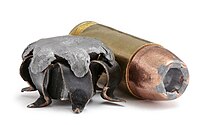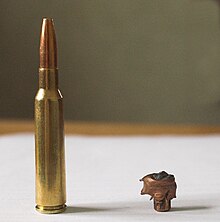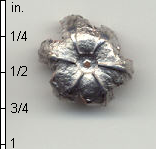
A bullet is a kinetic projectile, a component of firearm ammunition that is shot from a gun barrel. They are made of a variety of materials, such as copper, lead, steel, polymer, rubber and even wax; and are made in various shapes and constructions, including specialized functions such as hunting, target shooting, training, and combat. Bullets are often tapered, making them more aerodynamic. Bullet size is expressed by weight and diameter in both imperial and metric measurement systems. Bullets do not normally contain explosives but strike or damage the intended target by transferring kinetic energy upon impact and penetration.

A cartridge, also known as a round, is a type of pre-assembled firearm ammunition packaging a projectile, a propellant substance and an ignition device (primer) within a metallic, paper, or plastic case that is precisely made to fit within the barrel chamber of a breechloading gun, for convenient transportation and handling during shooting. Although in popular usage the term "bullet" is often used to refer to a complete cartridge, the correct usage only refers to the projectile.

Terminal ballistics is a sub-field of ballistics concerned with the behavior and effects of a projectile when it hits and transfers its energy to a target.

Expanding bullets, also known colloquially as dumdum bullets, are projectiles designed to expand on impact. This causes the bullet to increase in diameter, to combat over-penetration and produce a larger wound, thus dealing more damage to a living target. For this reason, they are used for hunting and by most police departments, but are generally prohibited for use in war. Two typical designs are the hollow-point bullet and the soft-point bullet.

The .45 ACP, also known as .45 Auto, .45 Automatic, or 11.43×23mm is a rimless straight-walled handgun cartridge designed by John Moses Browning in 1904, for use in his prototype Colt semi-automatic pistol. After successful military trials, it was adopted as the standard chambering for Colt's M1911 pistol. The round was developed due to a lack of stopping power experienced in the Moro Rebellion in places like Sulu. The issued ammunition, .38 Long Colt, had proved inadequate, motivating the search for a better cartridge. This experience and the Thompson–LaGarde Tests of 1904 led the Army and the Cavalry to decide that a minimum of .45 caliber was required in a new handgun cartridge.

The .357 Smith & Wesson Magnum, .357 S&W Magnum, .357 Magnum, or 9×33mmR is a smokeless powder cartridge with a 0.357 in (9.07 mm) bullet diameter. It was created by Elmer Keith, Phillip B. Sharpe, and Douglas B. Wesson of firearm manufacturers Smith & Wesson and Winchester. The .357 Magnum cartridge is notable for its highly effective terminal ballistics.

A rim-fire is a type of metallic cartridge used in firearms, where the primer is located within a hollow circumferential rim protruding from the base of its casing. When fired, the gun's firing pin will strike and crush the rim against the edge of the barrel breech, sparking the primer compound within the rim, and in turn ignite the propellant within the case. Invented in 1845, by Louis-Nicolas Flobert, the first rimfire metallic cartridge was the .22 BB Cap cartridge, which consisted of a percussion cap with a bullet attached to the top. While many other different cartridge priming methods have been tried since the early 19th century, such as teat-fire and pinfire, only small caliber rimfire and centerfire cartridges have survived to the present day with regular use. The .22 Long Rifle rimfire cartridge, introduced in 1887, is by far the most common ammunition found in the world today in terms of units manufactured and sold.

A soft-point bullet (SP), also known as a soft-nosed bullet, is a jacketed expanding bullet with a soft metal core enclosed by a stronger metal jacket left open at the forward tip. A soft-point bullet is intended to expand upon striking flesh to cause a wound diameter greater than the bullet diameter. Jacketed soft point bullets are usually abbreviated JSP in the ammunition and reloading industry. The use of soft-point bullets in warfare is a violation of the Hague Convention of 1899, declaration IV, 3.
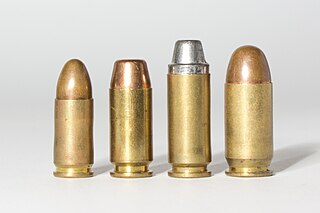
The 9×19mm Parabellum is a rimless, tapered firearms cartridge.

The .22 Long Rifle, also known as the .22LR or 5.6×15mmR, is a long-established variety of .22 caliber rimfire ammunition originating from the United States. It is used in a wide range of firearms including rifles, pistols, revolvers, and submachine guns.
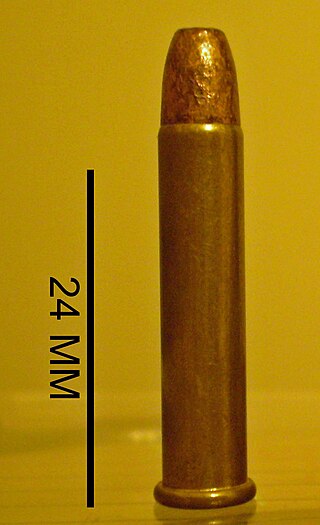
The .22 Winchester Magnum Rimfire, also known as the .22 WMR, .22 Magnum, .22 WMRF, .22 MRF, or .22 Mag, is a rimfire cartridge. Originally loaded with a bullet weight of 40 grains (2.6 g) delivering velocities in the 2,000 feet per second (610 m/s) range from a rifle barrel, .22 WMR is now loaded with bullet weights ranging from 50 grains (3.2 g) at 1,530 feet per second (470 m/s) to 30 grains (1.9 g) at 2,200 feet per second (670 m/s).

Nosler, Inc. is an American manufacturing company based in Bend, Oregon, known for producing ammunition and handloading components and specializing in high-performance hollow-point and soft-point hunting bullets. The current companies also include subsidiaries Nosler Custom and Nosler Reloading. Nosler's contributions to shooting sports include both polymer-tipped bullet designs and new manufacturing techniques used in their production.
Stopping power is the ability of a weapon – typically a ranged weapon such as a firearm – to cause a target to be incapacitated or immobilized. Stopping power contrasts with lethality in that it pertains only to a weapon's ability to make the target cease action, regardless of whether or not death ultimately occurs. Which ammunition cartridges have the greatest stopping power is a much-debated topic.

.17 Hornady Magnum Rimfire, commonly known as the .17 HMR, is a rimfire rifle cartridge developed by Hornady in 2002. It was developed by necking down a .22 Winchester Magnum Rimfire case to take a .17 caliber (4.5 mm) projectile. Commonly loaded with a 17 grain projectile, it can deliver muzzle velocities in excess of 775 m/s (2,650 ft/s).
The 5.45×39mm cartridge is a rimless bottlenecked intermediate cartridge. It was introduced into service in 1974 by the Soviet Union for use with the new AK-74. The 5.45×39mm gradually supplemented and then largely replaced the 7.62×39mm cartridge in Soviet and Warsaw Pact service as the primary military service rifle cartridge.

Federal Premium Ammunition is a wholly-owned subsidiary of Vista Outdoor, located in Anoka, Minnesota. With a workforce of nearly 1,500, Federal manufactures shotshell, centerfire, and rimfire ammunition and components.

The 5 mm Remington Rimfire Magnum or 5 mm RFM is a bottlenecked rimfire cartridge introduced by Remington Arms Company in 1969. Remington chambered it in a pair of bolt-action rifles, the Model 591 and Model 592, but this ammunition never became very popular, and the rifles were discontinued in 1974. About 52,000 rifles and 30,000 barrels for the T/C Contender pistol were sold during its brief production run. Remington discontinued the cartridge itself in 1982, leaving owners with no source of ammunition.
The following are terms related to firearms and ammunition topics.

Black Talon is a brand of hollow-point pistol and rifle ammunition introduced in 1991 by Winchester, primarily intended for law enforcement and personal defense use. Black Talon rounds were known for the unique construction of the bullet and its sharp petal shape after expansion following impact with tissue or other wet media. Black Talon ammunition was produced in the following calibers: 9mm Luger, 10mm Auto, .40 S&W, .45 ACP, .357 Magnum, .44 Magnum, .300 Winchester Magnum, .308 Winchester, .338 Winchester Magnum, and .30-06 Springfield.

The .44 Henry, also known as the .44 Henry Flat, the .44 Rimfire, the .44 Long Rimfire, and the 11x23mmR in Europe, is a rimfire rifle and handgun cartridge featuring a .875 in (22.2 mm)-long brass or copper case. The round has a total overall length of 1.345 in (34.2 mm), with a 200 or 216 gr .446 in (11.3 mm)-diameter cast solid-lead heeled bullet. The original propellant load is 26 to 28 gr of black powder. The round has a muzzle velocity of approximately 1,125 ft/s (343 m/s), giving a muzzle energy of 568 foot-pounds.




